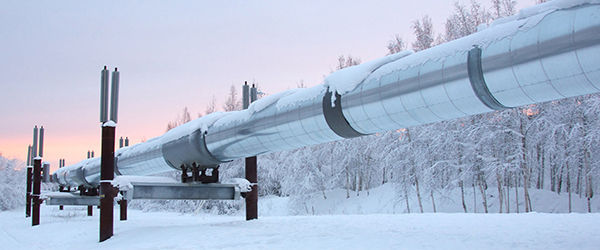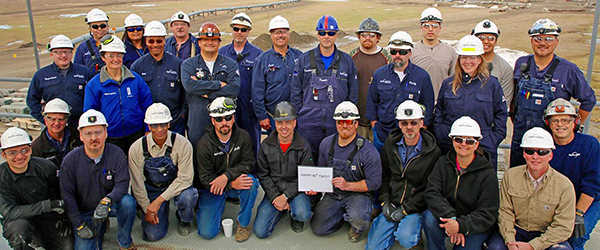2006: An oral history of the great flood
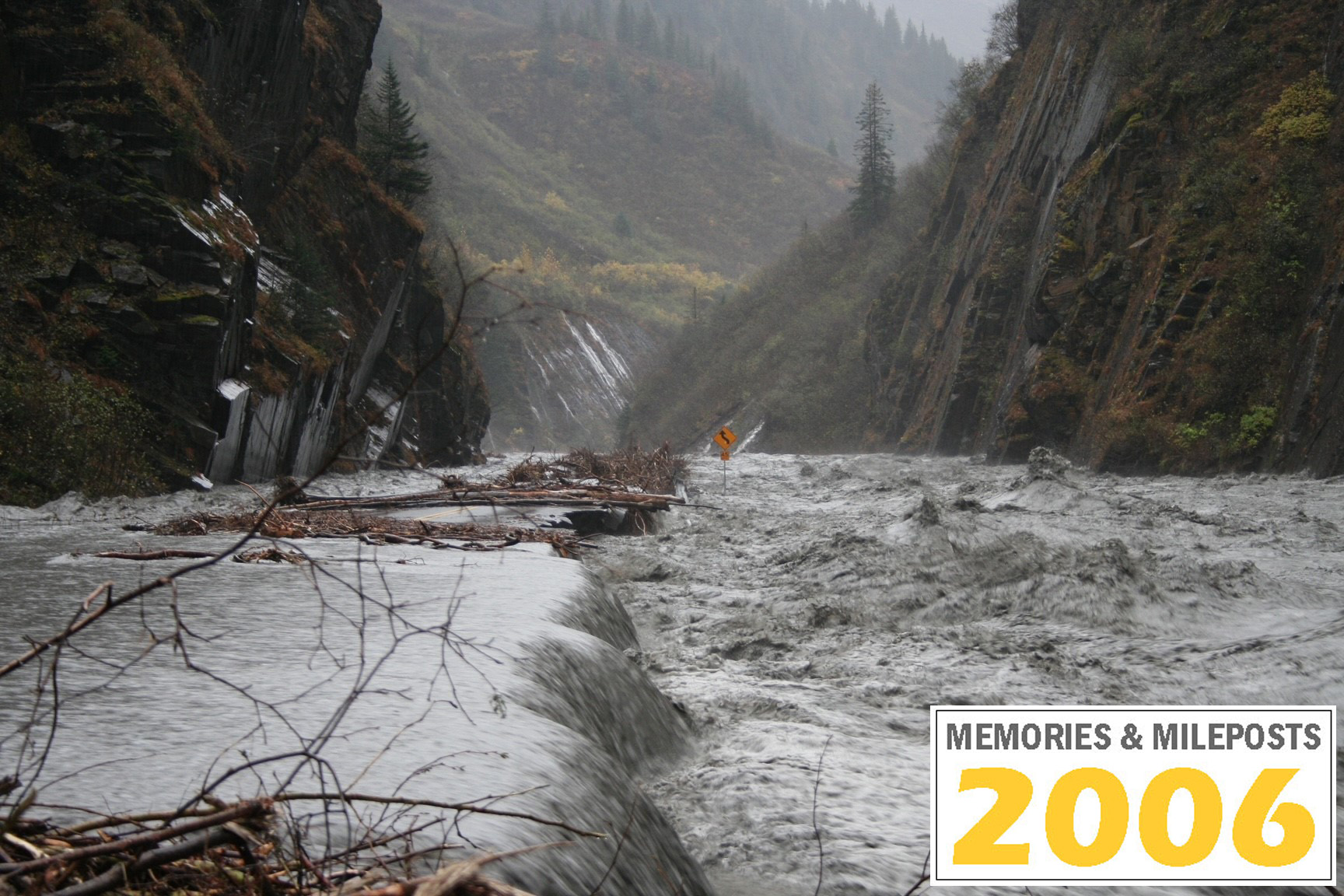
During the fall of 2006, the Valdez area experienced a significant flooding event, which overwhelmed rivers and creeks, closed the Richardson Highway – the only road to town – and caused damage to local/area roads bridges and property. The event, which peaked from Oct. 9-11, also caused major disruptions to Valdez Marine Terminal operations, requiring an incident management team and lots of hard, wet work. Dive into the deep end of the event in this retrospective, as told by several Alyeska employees who were there.
“When it rains, it pours”
Megan Woods (Operations Supervisor, then Maintenance Planner): “Flooding in Valdez is pretty common, although not to the degree of damage like in 2006! We have a well-known reputation for ‘when it rains, it pours.’ When the clouds roll in, they get trapped by the beautiful mountains that surround the town and terminal.”
Brian MacDonald (Maintenance Supervisor, then Ahtna Superintendent): “We have seen a few floods over the years, in most cases you learn to deal with it. … Most individuals that have spent a good portion of their time in Valdez know that working in regular and increased rainfall is part of our normal business.”
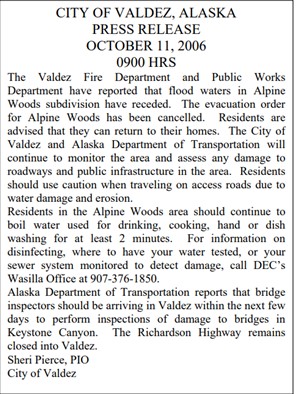 “It quickly became all hands on deck”
“It quickly became all hands on deck”
While precipitation is a near constant in the Prince William Sound rainforest, there was something different about Oct. 2006.
Laura Meadors (retired, then Engineering Supervisor): “We had an early, heavy, deep snow in the higher elevations around Valdez the week or so before an exceptionally large rain event. Not only did we have runoff with the rain, we also had runoff created by the snow mass collapsing and melting. It was a very unusual set of circumstances.”
Cameron Hursh (PS5 Mechanical Maintenance Technician, then VMT Mechanical Maintenance Technician): “Ground that normally doesn’t see water was vulnerable to washing out, taking trees and debris with it, which went downstream and clogged up bridges.”
MacDonald: “The water runoff, and the speed in which it rose at the VMT and around town including Keystone Canyon, happened relatively fast and was very impressive.”
Oct.9: Records smashed, community splashed
According to the National Weather Service, on Monday, Oct. 9, Valdez received 4.6 inches of rain, breaking its 24-hour record. Areas north of town saw even more rain. That morning, the impacts to creeks and streams were noticeable and worrying.
Meadors: “On Monday, over the lunch hour, I walked over to the eastside of the Valdez Terminal Office (VTO) to take a look at Allison Creek. A few people had congregated at the east-facing windows on the third floor. You could see big, chocolate brown standing waves in Allison Creek. That’s when I knew things were really getting serious. Others who went near the creek heard what sounded like boulders tumbling down with the flow.”
Hursh: “It quickly became all hands on deck. Most drains and culverts around town clogged and flooded, leaving a lot of water backed up. The Alpine Woods subdivision had flowing water across yards. (Officials) closed some roads, like Dayville Road, with bridges at risk from high water and debris clogging.”
“Trees were washing down Allison Creek”
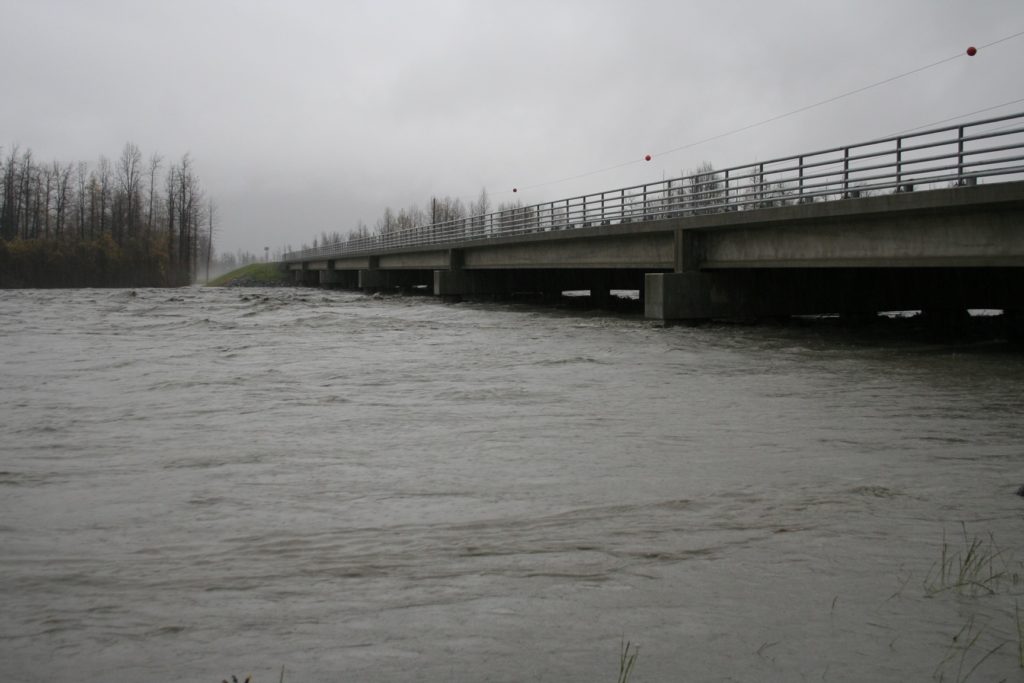
Right away, Alyeska leadership was particularly concerned about the Allison Creek bridge, which provides the only VMT vehicle access. The creek also provides water for drinking and industrial processes there.
Meadors: “By late afternoon, large trees were washing down Allison Creek and backing up against the bridge. The water never overtopped the bridge, but it came to within a foot or so of the bridge’s underside.”
Tom Stokes (retired, then Valdez Marine Terminal Director): “Alyeska and contractor personnel were using chainsaws to clear debris. At the same time, Engineering reviewed the structural design basis of the bridge. Due to the seismic design requirements for Valdez, Engineering determined the conditions we were experiencing were within the design basis of the bridge.”
For the safety of personnel, Alyeska arranged on-water transportation to the VMT for essential workers only.
MacDonald: “All non-essential employees were asked to evacuate. Those of us that stayed arrived daily for work on a Stan Stephens cruise boat.”
“An enormous amount of resources”
When it became clear that the flood response required coordinated resources and action from teams across the VMT and beyond, leadership mobilized an Incident Management Team (IMT).
Meadors: “By Monday night we stood up the IMT. We met in the Valdez Emergency Operations Center (VEOC) after dinner to kick off the IMT and discuss actions to be taken over next 24 hours. IMT shifts were limited to a 12-hour-day shift.”
Stokes: “We were in constant contact with leadership and response personnel from City of Valdez, State of Alaska, and the oil producers.”
Meadors: “The IMT was established to set objectives, marshal resources, support the field response, and manage information flow to/from the TAPS workforce and Valdez community. Fortunately, we had access to an enormous amount of resources from our normal operations, as well as spill prevention and response.”
Stokes: “Water was overtopping the Richardson Highway at multiple locations between Keystone Canyon and Squirrel Creek. Alyeska was flying helicopters over the pipeline to ensure system integrity.”
VMT water systems were impacted by the Allison Creek flood and operating at capacity.
Stokes: “From an operational perspective, heavy rain impacts the Ballast Water Treatment (BWT) facility as many of the VMT’s drainage systems, such as tank farm catch basins, are routed to BWT. Large volumes of water can upset the treatment process.”
Chris Derifield (Operations Technician at BWT): “Every treatment system was maxed out. Luckily, we got through it without overflowing any tanks. We had an infiltration problem into the sewage treatment plant. It was about one foot from overflowing the inlet wall and thankfully we got Petro Management Services here in time to vac it down, giving us time to find the problem. I remember looking at the level rising and not being able do anything to stop it.”
“Abercrombie Creek has jumped its bank”
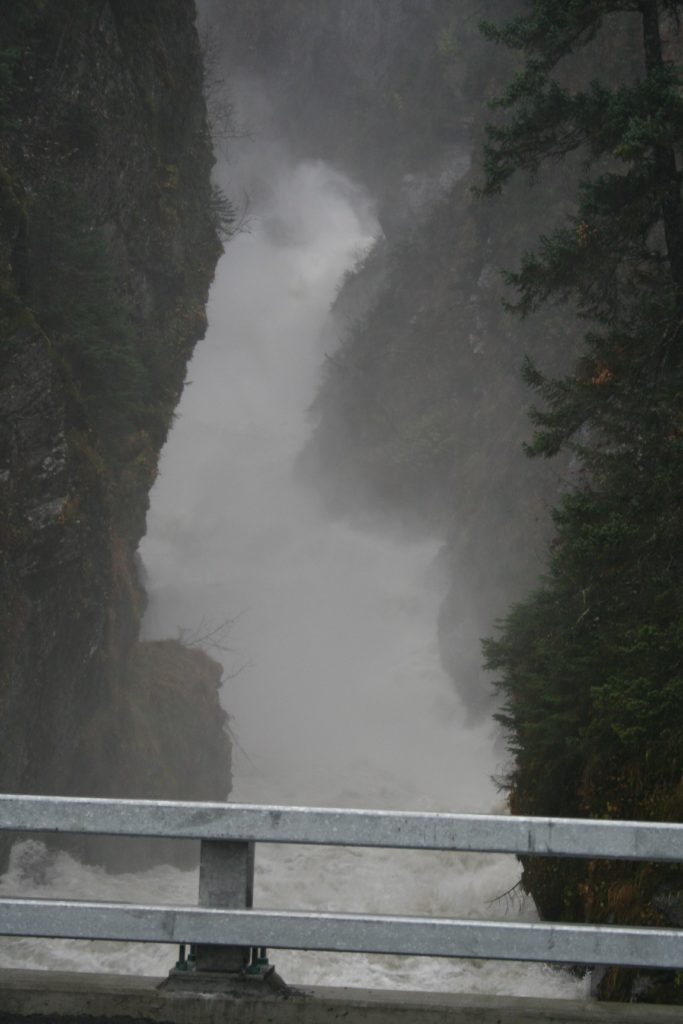
As the response entered its second day, another crisis was incoming. Three miles away, a TAPS metering station was under threat from nearby Abercrombie Creek. This facility measures oil as it leaves TAPS for the PetroStar refinery and any residuum that returns to the pipeline. An upset there could cause a pipeline shutdown.
Meadors: “The IMT Operations Section deployed the helicopter to conduct aerial surveillance, which verified Abercrombie Creek had jumped its bank and it was taking a straight path past the westside of the metering facility, headed to the bay.”
Stokes: “Water was eroding dirt underneath the building.”
MacDonald: “I was originally called by Doug Fleming to look at the damage created by the compromised dike as water flowed into the corners of the PetroStar skid. Doug and I walked through the thigh-deep water to assess it.”
“Calvary arriving over the hill”
With a facility critical to operation of TAPS at risk, response leadership quickly deployed personnel and equipment.
Stokes: “Alyeska crews and contractors cleared rocks and debris from the creek, fortified the banks to re-establish creek channel, and rebuilt the metering building foundation.”
MacDonald: “We mobilized all available Operators and Equipment to PetroStar and the Allison Creek Bridge. I worked at PetroStar running a D8 Dozer in the river pushing material from the canyon to use for a new dike while rock trucks/loaders delivered as much rip rap as we could find in an effort to redirect the water flow to its original path.”
Meadors: “Had we waited much longer, they likely would not have been successful in redirecting Abercrombie Creek back to its normal (circuitous) flow path. The quick work by the ’yellow iron heroes’ prevented us from losing the metering station. If that happened, we likely would have experienced a longer disruption to TAPS and a release of crude oil to the waters of Prince William Sound.”
Stokes: “The PetroStar manager had a young son who was a fan of superhero cartoons. His son’s eyes were big when he was told there were heroes living and working in Valdez. The manager described the response from the VMT was like the calvary arriving over the hill.”
While many were amid the action, others supported the work from elsewhere on the VMT or at SERVS.
Meadors: “My IMT role was Community Liaison. I supported Incident Command and fielded questions from City of Valdez personnel and the public. Tom Stokes and I attended the normally scheduled Valdez City Council meeting that week to provide a TAPS update. The whole meeting was devoted to discussing the flood situation.”
Woods: “I wasn’t an essential worker so I worked from SERVS until the road opened back up. I think it was only a few days until it was inspected and deemed safe. I remember Cameron Hursh drove to the canyon and took photos and videos of the raging river. I’m pretty sure that’s where the Anchorage Daily News got all its photos.”
Hursh: “I was on-shift when it happened but couldn’t get to work because of the roads/bridges. I decided to be adventurous and go see the crazy weather. I grabbed Jeff Woods and went all around the Valdez area taking pictures; the rivers were crazy swollen.”
After the flood
As the waters receded on Oct. 11, the immediate response came to a close but significant work and impacts remained.
Meadors: “The silt and debris that washed into the Abercrombie Creek flood plain (the inland ponded area on the shore side of Dayville Road) raised the elevation by several feet, increasing the potential for future flooding in the area.”
Stokes: “State DOT personnel traveled with our crews to determine Richardson Highway conditions and initiate temporary repair plans before winter. There was a fair amount of civil work performed after the flood. A lot of work was performed immediately and into the following year.”
Derifield: “The creek was stirred up with sediment for quite some time and it was months before the turbidity was low enough to treat the raw water through our systems.”
Hursh: “I had experience running an excavator, so I volunteered to do that. I worked on the ditch next to the Lower 19 road across from East Meters. It was messed up with big rocks and debris.”
Woods: “I recall the runway being shut down for a period of time, but not as long as the road. People immediately started emptying shelves at the grocery store, hoarding food. Luckily the store was able to coordinate shipment by barge.”
In town, Mineral Creek Bridge had washed out and more than 60 homes suffered significant damage, as did several bridges in Keystone Canyon Many residents were stranded in their homes or elsewhere for days. TAPS experienced a brief shutdown when the Operations Control Center lost communication with RGV 123. But, considering the historic nature of the flood, it could have been much worse. Quick and organized action by TAPS’ experienced professionals kept the VMT from major impacts.
Stokes: “It was impressive to witness the professionalism, hard work, and ‘can-do’ attitude by Alyeska and contractor personnel.”
